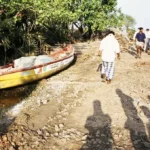In a strongly worded order dated July 11, 2024, the National Green Tribunal (NGT) expressed deep disappointment with the Ministry of Jal Shakti and the Central Water Commission (CWC) for their lack of response and inaction regarding illegal mining near the Taj Mahal and along the Yamuna River’s flood plains.
Case No. 316/2022 was initiated from a letter petition by Dr. Sharad Gupta, highlighting a Times of India article published on March 6, 2022. The petition drew attention to illegal mining destroying sand dunes and ravines near the Taj Mahal and within the restricted flood plain zone of the Yamuna River.
The NGT took suo moto cognizance of the matter on May 9, 2022. Since then, it has issued orders directing authorities to demarcate the flood plain zone of the Yamuna River, a crucial step in addressing the illegal mining issue.
On September 5, 2023, the CWC, under the Ministry of Jal Shakti, issued an office memorandum. It established a committee to identify and demarcate the Flood Plain Zone of the Yamuna River, from Asgarpur in Haryana’s Yamunanagar district to Etawah, and from Shahpur to Prayagraj, with a four-month deadline.
The Tribunal is losing patience due to the absence of Ministry of Jal Shakti and CWC representatives during hearings, and their failure to submit progress reports on the demarcation work.
The bench order by Justice Sudhir Agarwal and Expert Member Dr. Afroz Ahmad highlighted that despite the four months expiring in January 2024, no information was provided to the Tribunal regarding the task completion or enforcement by the authorities.
The Tribunal was frustrated by the Ministry of Jal Shakti’s defiant attitude. Notices were issued on September 20, 2022, and subsequent orders on January 10, 2023, April 10, 2023, May 18, 2023, and November 23, 2023, showed a consistent pattern of non-representation and non-response.
Due to the ongoing non-compliance, the NGT impleaded the CWC as the ninth respondent and issued a notice on June 7, 2024. Despite this, neither the Ministry nor the CWC responded, leaving the Tribunal unaware of the flood plain zone identification progress.
During the latest hearing, Advocate Gi. Gi. C. George, representing both the Ministry and the CWC, appeared before the Tribunal. However, he was unable to provide any substantive information or justification for the prolonged delay in filing responses, despite the notices being served almost two years ago in the Ministry’s case.
The NGT expressed concern over the delay, stating, “No reason has been placed before us to justify this attitude of delaying the matter adopted by said two respondents in such a serious and important issue involving environmental destruction near historical places like Taj Mahal (TTZ area) and the River Yamuna, known as lifeline of North India.”
The Tribunal noted that the respondents’ inaction wasted the court’s time and delayed the proceedings without valid reason. This delay is concerning given the environmental stakes, especially in areas like the Taj Mahal and the Yamuna River, referred to as North India’s lifeline.
In response to the non-compliance, the NGT has granted a final three-week period to the Ministry of Jal Shakti and the CWC to file their replies and provide information regarding the compliance with the September 5, 2023 office memorandum. However, this extension comes with a caveat – the respondents are required to pay a cost of Rs. 50,000 to the Registrar General of the Tribunal before the next hearing.




